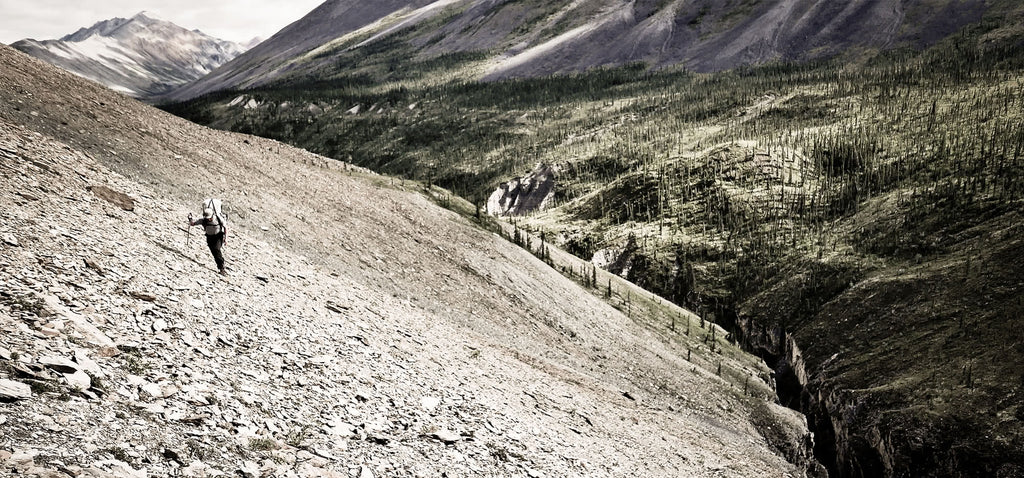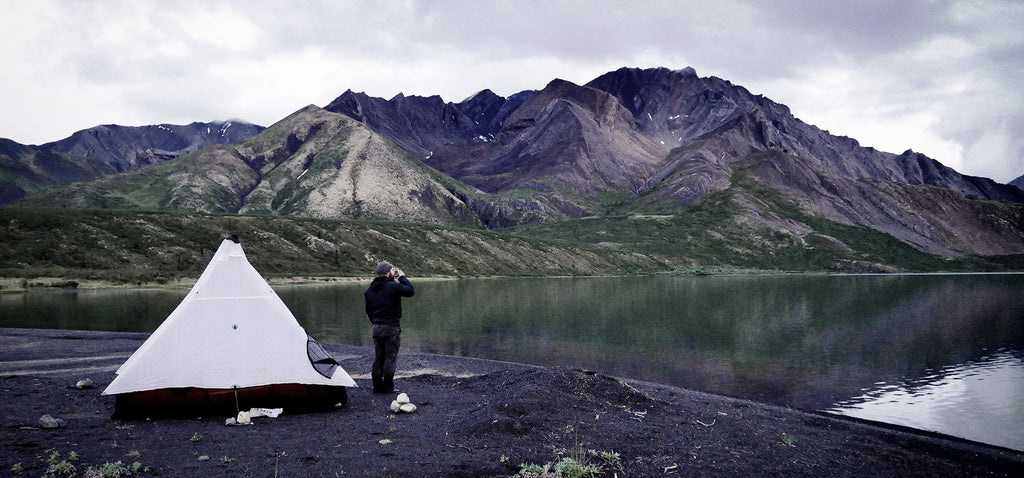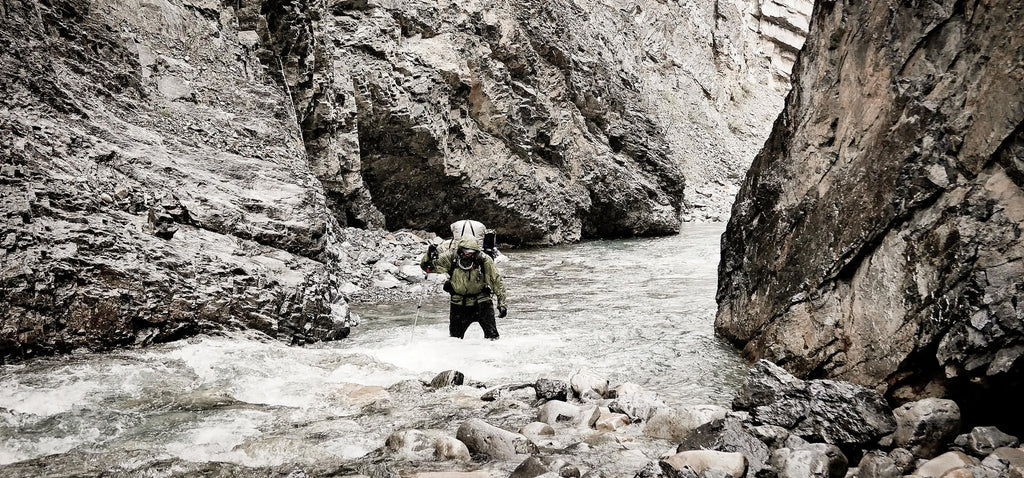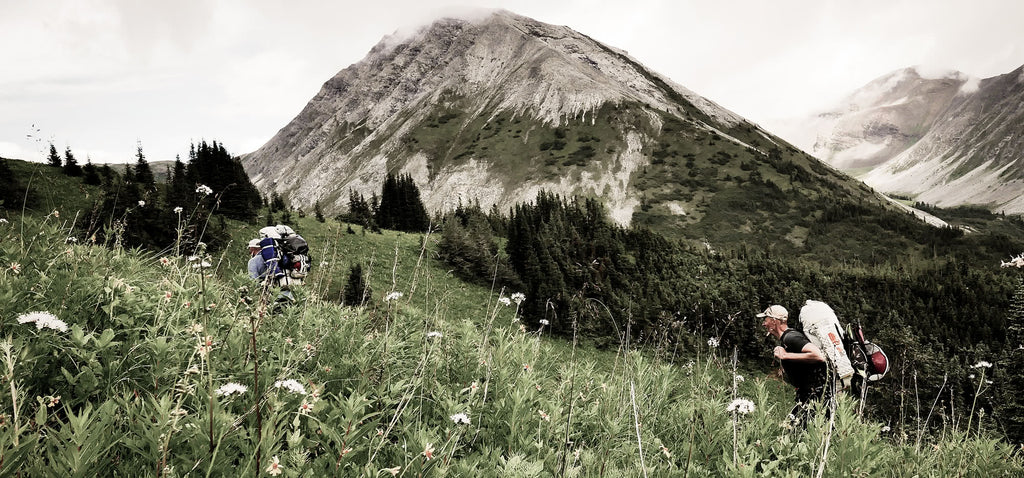Oh, Canada: Fat Rafting Kluane National Park
June 16, 2017
Words & Photos by Paul Burbidge // Videos by Dylan Stewart
We’d made the Mackenzie River and the trip was over. We still had 100 kilometers of river to paddle but the unknowns were behind us and we started paddling by ourselves, in our own heads. We were already partly home and tied up with future activities, work, spouses etc. Or maybe this was just me. I struggle with being able to see my future. The Mackenzie River is wide, slow and straight. Wide means two kilometers wide and straight means sections long enough that the river has a horizon line- like the ocean. There is no unknown. Our next few hours were laid out in front of us. They would be long and hot and we’d have to paddle to make up for the lack of current. Our paddling didn’t seem to have any effect but we moved along.

The easy living of the trip was over. Maybe easy isn’t the right word. Simple? Wake up, hike or paddle, enjoy food that would make you gag at home, find a nice camp, face a bunch of unknowns, and enjoy being out there. Some of the simple was quite hard (150 kilometers of portaging with no trails, difficult rivers) but it was simple. Hiking is simple: put one foot in front of the other, try not to lose elevation unnecessarily, don’t kick too many rocks with your sore toes. Paddling is simple: assess the rivers’ difficulty as you go—too difficult?; get out and carry your boat until you feel it’s safe; close your relief zipper before you jump in to cool off. Simple.
Simple because you trust your trip mates and their abilities. No one needs to look out for anyone but everyone does. You know they’ll pick a good camp, a good line through the rapid or a good way to skirt a canyon. You don’t need to talk about it but you do because that’s what there is to talk about.

So how did we get to the Mackenzie and where did all this simple living take place? Our entire crew are basically Google Earth addicts, searching for ways to link different areas together with entertaining paddling and scenic hiking. We get off the beaten path, actually there are no paths. Most of the fun of these trips is not knowing what’s coming up and developing the skills to deal with it.
We’d all done trips in the Mackenzie Mountains but not the Nahanni. I’ve read everything I could about the Nahanni for years and was keen to take a look. How couldn’t you be? Broken Skull, Hell Roaring Creek, Black Wolf, Thundercloud, Raven’s Throat, and Vampire Spires—the names alone are enough to go and take a look.

We cooked up a packraft route that started on the Little Nahanni River, which flows from the Yukon/NWT border. The Little Nahanni is often done by canoeists over the course of a week or so. It has many difficult rapids including Crooked Canyon and the Step. The Little Nahanni was running high and fun. Sky had a swim in Crooked Canyon that shook his confidence a bit, but we took a short break and Sky got back in his boat and paddled the rest of the canyon well. We gave ourselves a day to get down the Little Nahanni and five kilometers of the South Nahanni before we started our first portage.
We hit our pullout spot on the South Nahanni in the early afternoon and decided to start the portage. We were carrying full whitewater boat kits (19 pounds each) and 21 days’ food. We’d thrown around the idea of a food drop but decided the added complexity, cost and intrusion weren’t worth it. We may have had second thoughts as we headed straight up a willow choked mountain. Our route would have us gaining the summit ridge and following it for about a day before dropping into the valley of an unnamed river. Bugs and rain accompanied us as we groveled up the climb. At 10 pm we were out of water and energy and decided to camp. We threw up the Ultamid shelters and tarps and ate a dry dinner. In the middle of the night heavy rains returned and we were able to collect several liters of water off the tarps-we’d have coffee!

The remainder of the hike to unnamed river was tough but stunning. After a few kilometers of hiking down the river we’d gained enough water to blow up our Alpacka Rafts and paddle. We needn’t have bothered; we were soon stopped by two waterfalls with nasty portages. Very heavy rain hung with us as we made the second long portage through the willows. We were soaked and a little cranky when we got back in the boats. Would the unnamed river have another waterfall around the next bend? What we found instead was a glorious and scenic campsite-just when we needed it. The rest of the unnamed river to the confluence with the Broken Skull River was pretty and interesting with no major rapids. After reaching the Broken Skull we paddled down to Grizzly Bear Creek which was the start of our next portage.
Paul and Sky had decided that they didn’t want to paddle our next objective-Black Wolf Creek. When we were planning the trip we thought we might be getting the first crack at what looked like a really good river but some Americans had the same idea. We found out about their plans and met them for beers when they passed through Yukon for their trip. We all wished each other good luck on our trips and agreed not to share any intel on the Black Wolf until we’d all done it. In a way it was a bummer to split up for a few days but in the end it was for the best. Paul and Sky took our extra food and paddled down the Broken Skull to wait for us. Dylan and I hiked up Grizzly Bear Creek and had a nice soak at the hot springs near the creek. We continued on to Grizzly Bear Lake and spent the night in one of the nicest places I’ve been.

In the morning we paddled out of the lake and into Black Wolf Creek. The creek started mellow but by late afternoon was continuous Class 3+ white water. There were certainly some class 4 features thrown in for good measure. The river remained relatively low volume but the gradient was steep as hell. Dylan and I have done lots of white water paddling together and quickly fell in step. We went down the river with head nods as our primary means of communication. The creek flows through a spectacular valley that reminded us a bit of the Carcajou Canyon we’d been in two years earlier. Unfortunately we got few photos of the Black Wolf as we both needed to paddle at the same time for safety.
The unknown nature of the river and the gradient wore us down as the day went on. The river always appears to be entering a canyon around the next bend due to how steep it is. The difficulty of the river was harder than the Little Nahanni and it was relentless. We were both aware that a swim would be bad. There were very few eddies and boat retrieval would be very difficult with only the two of us. What if you can’t catch your boat right away? It’s gone-likely shredded below in some unknown and waiting canyon. You take a helicopter out and ruin your friends’ trip. We didn’t want to lose a boat.
Eventually we did find a nasty boat-shredding canyon formed by a rock slide, but after scouting we realized it would go. We both got humbled a bit but came through unscathed. The river continued to test us until we came to another canyon. A quick scout revealed this was a walk as the canyon was nasty looking with an ugly waterfall entrance. We decided to camp at the head of the canyon and walk around in the morning.

In the morning we were refreshed and ready to go again after our portage. The river was the same but felt friendlier. We did one short portage around a river-wide pour over and scouted two more canyons that proved runnable. The mountains remained spectacular and as the river eased, toward the Broken Skull, we had more time to enjoy them. We arrived at the confluence with the Broken Skull and were glad to see Sky and Paul. We decided to knock off early for the only time during the trip and did laundry in our Porter packs–good for keeping water IN too.
Our next phase was to paddle the rest of the Broken Skull and then the South Nahanni as far as Hell Roaring Creek. The major danger was drifting into a sweeper while sleeping; Dylan and I were saved from dunks by shouts from more alert trip members. Once we reached Hell Roaring Creek, the big hike began. We figured on 100 kilometers up Hell Roaring and Flood Creeks and then down Thundercloud Creek until we had enough water to paddle. The hike up Flood Creek was an unexpected highlight.

The lower creek was several hundred meters wide and then suddenly constricted to a few meters as we headed upstream. We had some chilly times where the canyon was wall-to-wall in moving water and it was raining heavily. We all felt a little tense as a slot canyon isn’t the ideal place to weather a rain storm. Eventually we reached a waterfall we couldn’t get up. A sketchy ramp got us out of the canyon after Paul went up and tied off a fixed line. Once we popped out we were in an amazing green valley cut with the Flood Creek canyon and several feeder canyons. These feeder canyons proved tricky to get around. Just upstream a great campsite was waiting for us.

The next day we reached Thundercloud Creek and were able to blow up the boats we’d been carrying for 3.5 days. We’d had heavy rains and thunderstorms, for hours on end, the previous night and during the day. The creek passed through several interesting ponds as it made its way along the south side of the valley. Sheep watched us pass by as they sheltered under cliffs from more storms.
Thundercloud Creek was in flood. The flood waters quickly carried us down the Thundercloud, Silverberry, Raven’s Throat and Redstone. We made easy 100 kilometer days but took our time scouting canyons that were extremely turbulent in the flood levels. In one boily canyon Dylan’s entire raft was sucked under by the sudden appearance of a whirlpool. He fought it hard and ended up going under still square in his boat. Fortunately he popped up a few seconds later and climbed back in his boat to finish the canyon.
The country we passed through softened as we approached the confluence of the Redstone and Mackenzie. The mountains shrank and softened. The river slowed. The rivers dropped by a foot or more each night as the rain had stopped.
While most of this post has focused on what we did, that’s not what makes a trip. Even the place doesn’t make the trip (although it can unmake it). What makes the trip is the experience. Or maybe the experience is just the place and people together, I don’t know. Getting together with friends and doing something that’s a little crazy until it seems normal, like everyday life, maybe that’s the experience?
In any case, I’d like to thank Sky, Paul and Dylan for an awesome trip. Thanks to Tony for dropping us off, we missed you out there. Huge thanks to Carrie for lots of help with this post. Thanks also go to Hyperlite Mountain Gear, Alpacka Raft and MEC for their support. Filming was done with the permission of Parks Canada Agency, in Nááts’ihch’oh National Park Reserve and Nahanni National Park Reserve. These parks have great trip planners available online and are Canada’s packraft nirvana.
Paul Burbidge and his expedition partners, Dylan Stewart Paul Christensen and Sky Pearson are regularly exploring remote parts of Northern Canada and pushing the limits of what’s possible in a packraft. On this trip they put our Ultamid Pyramid Tents + Inserts, Flat Tarps, and 4400 Porter pack to the test. For more in-depth trip reports, photos and videos from their time exploring Canada, check out Paul on Exposure.co.
YOUR CART IS EMPTY
Let’s find you the right gear for
your next adventure.